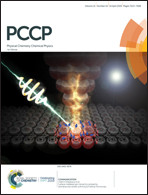Thermodynamics of adsorption of lysozyme on gold nanoparticles from second harmonic light scattering†
Abstract
Gold nanoparticle (GNP) interaction with hen egg white lysozyme (Lyz) has been investigated by many groups in order to understand protein mediated aggregation of GNPs and the underlying mechanism of aggregation. In this article, we have studied the interaction of citrate-capped GNPs of 16, 28, 41, and 69 nm sizes with Lyz by the non-destructive label-free second harmonic light scattering (SHLS) technique at physiological pH in phosphate buffer. The surface sensitivity of the nonlinear optical SHLS technique is very high and we have looked at the GNP–Lyz interaction at nanomolar concentrations. We have followed the increase in the SHLS intensity of GNPs as a function of the added concentration of Lyz in small aliquots. The SH intensity profile exhibits saturation behaviour and was fitted with a modified Langmuir adsorption model which yielded the binding constant (Kb), the binding stoichiometry (nsat) at saturation and the free energy change (ΔG) in the adsorption process. The free energy change was further decomposed into changes in the enthalpy (ΔH) and entropy (ΔS) of adsorption by carrying out temperature dependent SHLS measurements in a specially designed cell. The thermodynamic quantities extracted from the measurements show that the binding is exothermic (ΔH < 0) as well as spontaneous (ΔS > 0). We find that the first step in the adsorption of Lyz on the GNP surface is nanoparticle protein corona (NP-PC) formation driven predominantly by electrostatic attraction. In the second step of adsorption, the adsorbed lysozymes on the surface form a bridge between two or more GNPs leading to the latter's aggregation, which is the main reason for the enhancement of the SH scattering signal. Although the interaction between the GNPs and Lyz is driven by strong electrostatic attraction, the thermodynamic quantities reported here indicate that the protein is physisorbed on the nanoparticle surface. We have also demonstrated that SHLS provides a new tool for full thermodynamic characterization of protein adsorption on metal nanoparticles at ultralow concentrations.



 Please wait while we load your content...
Please wait while we load your content...